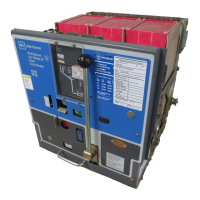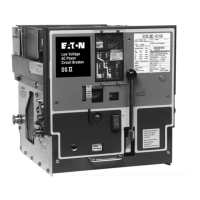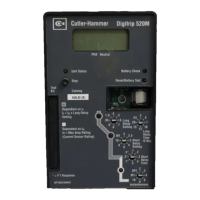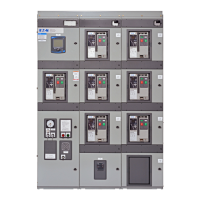1.8. 33-790-11
pose
of
this unique tripping concept is that selectivity and
continuity
of
service
in
un-faulted sections
of
the system
can be maintained
if
there is any need, but if there is no
previously operating load on the circuit, the instanta-
neous function takes over to limit extensive damage
which might occur due to a delayed tripping operation.
8.4 SERVICING OF AMPTECTOR TRIP UNIT
The Amptector trip unit is the intelligence
of
the overcur-
rent protection provided by the breaker. It is a device that
has many solid-state components. Since the only moving
parts are the adjustments, the Amptector trip unit will give
long, trouble-free service. All components and connec-
tions, including the printed circuit board itself are coated
to give effective environmental protection.
In
changing the Amptector trip unit settings, the dials
should be moved only
by
means
of
a small screw driver
inserted through the round hole in the faceplate directly
below the calibration window. The shafts must never be
rotated by applying torque directly to the dial as it has
only a friction fit on the shaft.
If it is suspected that the dial has moved on its shaft, it
may be checked by means
of
rotating the shaft counter-
clockwise to the limit
of
travel. A dot at the end
of
the cal-
ibration should lineup with the index mark on the
faceplate. See asterisk(*) on Figures
61
and 63.
If there is any reason to suspect that the Amptector trip
unit is not operating correctly IT SHOULD NOT BE TAM-
PERED WITH; SINCE TAMPERING COULD RESULT
IN
LOSS OF VITAL OVERCURRENT PROTECTION.
Note: Warranty on the Amptector trip unit will be void
if there is any evidence
of
tampering.
A specially designed tester is available for checking
Amptector trip unit operation without using primary cur-
rent. The tester can be plugged into any convenience
outlet; and will pass enough current to check any pickup
calibration. Time delay calibrations can also be checked.
Place drawout breakers
in
DISCONNECT position before
performing Amptector trip unit check.
Special handling and test equipment are required to ser-
vice solid-state devices.
If
use
of
the tester shows that
an
Amptector trip unit is not operating correctly, it is strongly
recommended that a spare Amptector trip unit be used;
and the questionable unit be returned to the factory for
service.
8.5 ACTUATOR
The actuator receives a tripping pulse from the Amptec-
tor trip unit, and produces a mechanical force to trip the
Effective October 1998
Page
61
breaker. Refer to Figures 64, 65 and 24 for location and
details. The actuator is made up
of
a permanent magnet,
a disc held by the magnet, a
rod
acted on by a spring, a
lever for tripping the breaker, and a lever for mechani-
cally resetting the actuator. The magnet cannot pull and
reset the disc against the force
of
the spring acting on the
rod, but can overcome the spring force when the disc is
in
contact with the magnet pole piece. A tripping pulse
from the Amptector trip unit counteracts the effect
of
the
permanent magnet, allowing the spring to separate the
disc from the magnet pole piece and move the rod to
actuate the trip shaft lever. The trip shaft lever then
rotates the trip shaft and trips the breaker. As the breaker
opens, the left pole unit lever pin strikes the spring finger
attached to the reset lever; this furnishes the assistance
required to move the disc so as to close the air gap
between it and the permanent magnet against the spring
force. The device is reset when the disc is
in
contact with
the magnet.
If
the disc is not fully reset, the trip shaft
lever will hold the breaker mechanism
in
the trip-free con-
dition; and the breaker cannot be reclosed.
The actuator must be replaced if it will not stay reset
when the plunger has been moved to the top
of
its travel.
TRIP SHAFT
ADJUSTING
SCREW----
MAGNET
ASSEMBL
¥--
..............
Fig. 64 Trip Actuator (391093)
8.6 SENSORS
The three sensors are located
at
the rear
of
the breaker
on
the lower studs, and directly behind the main discon-
necting contacts. Refer to Figure 66. They produce an
output proportional to the load current and furnish the
Amptector trip unit with the intelligence and energy to trip
Courtesy of NationalSwitchgear.com

